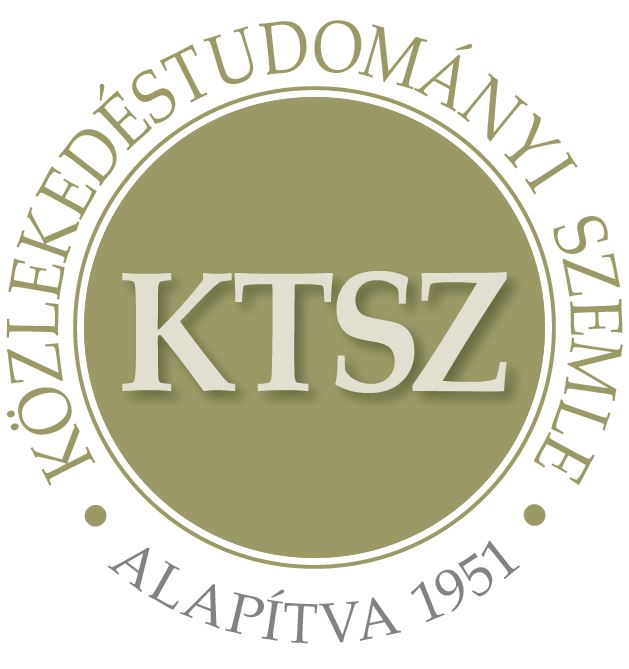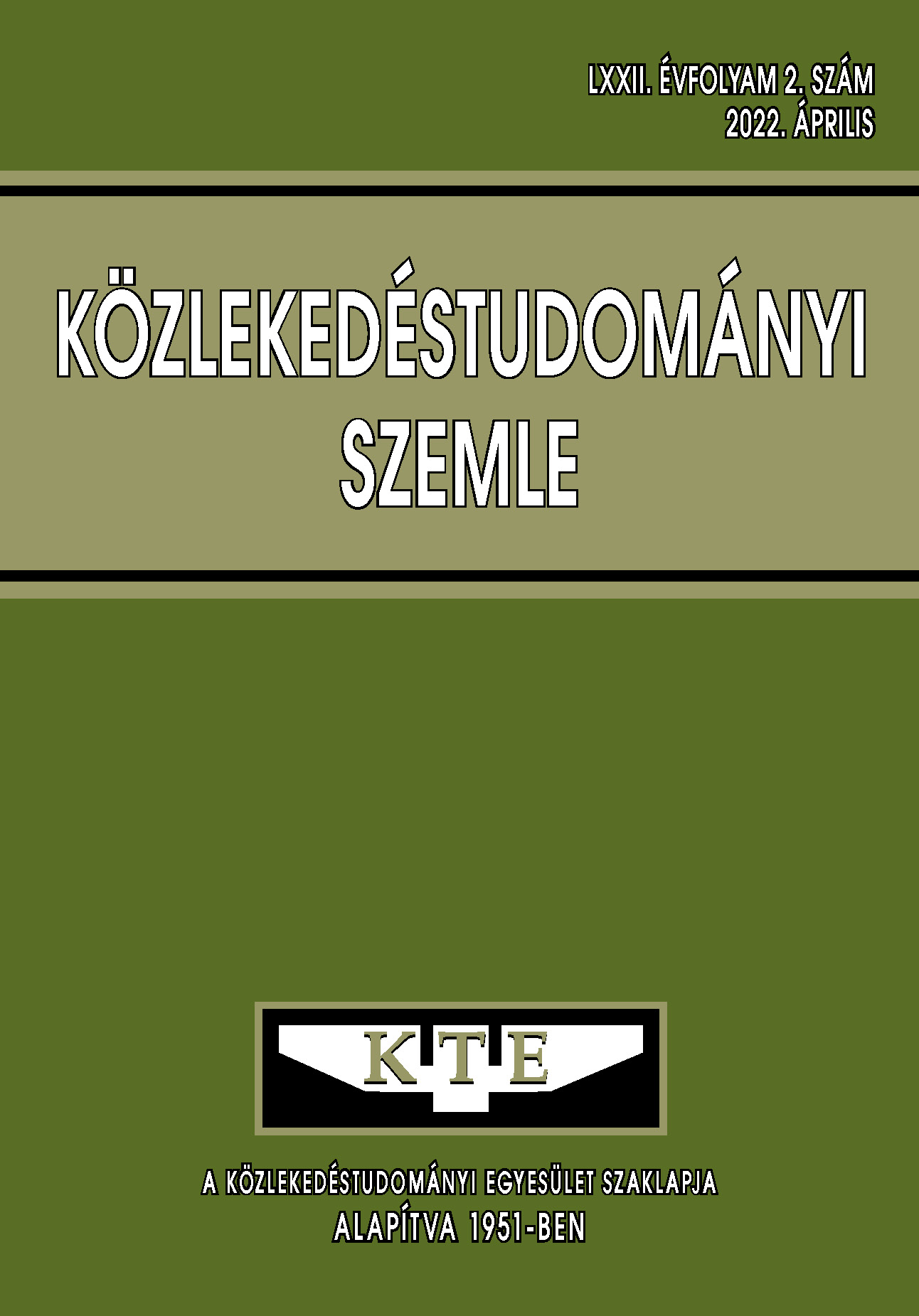Development of sustainable urban transport as shown on the example of Nantes
Abstract
According to some projections, by 2050, almost 80% of Europe's population will live in cities, which will cause complex social, economic, and environmental problems. As a result of the growing
population concentration, the share of car traffic is also increasing, which, in addition to the problems already mentioned, involves changes in transport policy, infrastructure, and technology, as well as causing changes in people's movement (use of space) and behaviour. The health values of cities and the quality of life of the population depend to a large extent on the conditions of transport, which should be developed in the direction of sustainable urban mobility in the future.
References
Allen, H. (2011): Integrated public transport, Nantes, France - Case study prepared for Global Report on Human Settlements 2013. https://unhabitat.org/sites/default/files/2013/06/GRHS.2013.Case_.Study_.Nantes.France.pdf
AURAN Cart’en main adatai alapján a szerző szerkesztése. cartenmain.auran.org/visualiser/mobilite#layers=56365700dca44d92a5e8afc077de57cc
data.nantesmetropole.fr adatai alapján a szerző szerkesztése. data.nantesmetropole.fr/explore/?disjunctive.diffuseur&disjunctive.
theme&disjunctive.features&disjunctive.publisher&disjunctive.gestionnaire&disjunctive.keyword&disjunctive.license&source=shared&sort=explore.popularity_score&geonav=world%2Fworld_fr%2Ffr_40_52%2Ffr_60_44%2Ffr_70_244400404&geonav-asc
Dotter, F. (szerk.) (2016): CIVITAS Insight - Planning for sustainable travel. https://civitas.eu/sites/default/f iles/civitas_insight_17_planning_for_sustainable_travel.pdf
Erdősi F. (2001): A fenntartható közlekedés megvalósíthatóságának nehézségei. Földrajzi Konferencia, Szeged 2001, 20 p. http://geography.hu/mfk2001/cikkek/Erdosi.pdf
Európai Közösségek Bizottsága (2007): Zöld Könyv. A városi mobilitás új kultúrája felé. Brüsszel, 25 p. https://eur-lex.europa.eu/legal-content/HU/TXT/PDF/?uri=CELEX:52007DC0551&from=HU
Európai Parlament és a Tanács 2008/50/EK irányelve (2008. május 21.) a környezeti levegő minőségéről és a Tisztább levegőt Európának elnevezésű programról. https://eur-lex.europa.eu/legal-ontent/HU/TXT/
PDF/?uri=CELEX:32008L0050&from=hu
Európai Parlament: Az Európai Parlament 2015. december 2-i állásfoglalása a fenntartható városi mobilitásról (2014/2242(INI)) (2017/C 399/02), Az Európai Unió Hivatalos Lapja, pp. 10-20. op.europa.eu/hu/publication-detail/-/publication/273c634bd0e0-11e7-a7df-01aa75ed71a1
European Environment Agency (The Noise Observation & Information Service for Europe), [49] és [51] adatai alapján a szerző szerkesztése
European Environment Agency Air Quality Statistics adatai https://www.eea.europa.eu/data-and-maps/dashboards/air-qualitystatistics
European Green Capital Award (2010): The Expert Panel's Evaluation Work & Final Recommendations for the European Green Capital Award of 2012 and 2013. https://ec.europa.eu/environment/europeangreencapital/wp-content/uploads/2011/05/Evaluation-Panel-Report-Award-Cycle-2012-2013.pdf
European Green Capital Award (2015): Expert Panel – Technical Assessment Synopsis Report. https://ec.europa.eu/environment/europeangreencapital/wpcontent/uploads/2015/04/EGCA-2017-Technical-Assessment-Synopsis-Report.pdf
Eurostat adatai alapján a szerző szerkesztése
Fleischer T. (2005): Fenntartható fejlődés – fenntartható közlekedés. Közúti és mélyépítési Szemle, 55. évf. 12. szám, pp. 2-9. http://www.vki.hu/~tfleisch/PDF/pdf05/fleischer_fe-fejl-fe-ozl_kmszle05-12.pdf
Gualdi, M. – Proietti, S. (2007): CIVITAS in Europe – ’A proven framework for progress in urban mobility’, Istituto Di Studi Per L’integrazione Dei Sistemi, 46 p.
Gudmundsson, H. (2015): The European Green Capital Award. Its
Role, Evaluation Criteria and Policy Implications. Toshi Keikaku 64(2), 7 p. https://backend.orbit.dtu.dk/ws/portalfiles/portal/110724430/313_Henrik_T2.pdf
Gulyás A. (2012): Városi közlekedés. Fenntartható mobilitás élhető városokban. Pollack Kiadó, Pécs, egyetemi jegyzet, 222 p. https://docplayer.hu/43059706-Dr-gulyasandras-varosi-kozlekedes.html
Hajnal, T. – Kerényi, L. S. – Fleischer, T. – Juhász, M. (2019): Budapest új mobilitási terve – A mobilitástervezés folyamata, előzmények, eredmények és további teendők, Városi Közlekedés, pp. 25-38. http://real.mtak.hu/104491/1/hajnal-kerenyi-fleischerjuhasz_budapest-uj-mobilitasi-terve_varkozl19-3-pp25-38.pdf
Holden, E. (2007): Achieving Sustainable Mobility. Everyday and Leisure-time Travel in the EU. Ashgate Publishing Limited, Aldershot (Egyesült Királyság), pp. 169-225.
https://civitas.eu/measure/creating-246-company-travel-plans
https://images.adsttc.com/media/images/5226/3b74/e8e4/4e33/d300/0103/slideshow/15.jpg?1378237280
https://hosting129892.a2e10.netcup.net/wp-content/uploads/2019/09/busway-Nantes-1_c-UTM-1024x683.jpg
https://www.tan.fr/medias/photo/visu_1593420222040-jpg?ID_FICHE=66437
https://img.20mn.fr/ROjN-oblTnWTnRBD2asrHw/830x532_stationvelos-
bicloo-ile-nantes.jpg
https://www.f loating-nantes.com/wpcontent/uploads/balade-velo-electriquenantes-44.jpg
http://www.tukebusz.hu/tartalmak/Tarsadalmi_egyeztetes_Fonodo_halozat
https://www.pecsma.hu/top/keszula-varos-uj-kozossegi-kozlekedesikoncepcioja-okos-buszkamerak-szamoljakaz-utasokat-felmer ik-a-buszoz as iszokasainkat/
https://www.pecsma.hu/top/nyolc-uj-pecsielektromos-busz-all-munkaba-jovore/
http://www.tukebusz.hu/tartalmak/automentes_nap_2021
https://civitas.eu/cities/budapest
https://civitas.eu/mobility-solutions/carfree-zone-strolling-zone-and-bicycle-pathnetwork
https://civitas.eu/mobility-solutions/establishing-a-zoned-parking-system-inthe-city-centre
https://www.eltis.org/mobility-plans/sump-concept
Hyatt, J. (2007): Fenntartható közlekedés a városban. Útmutató önkormányzatoknak. Zöld Fiatalok, Budapest, 54 p. http://mek.oszk.hu/08600/08649/08649.pdf
Jászberényi M. (2008): Fenntartható közlekedés Budapest agglomerációjában. PhD értekezés, Budapesti Corvinus Egyetem, pp. 28-58. http://phd.lib.uni-corvinus.hu/317/1/jaszberenyi_melinda.pdf
Journal de Nantes Métropole No.75 octobre-novembre 2018. https://en.calameo.com/read/00459045845d120ecdde7
Journal de Nantes Métropole No.86 avril 2021. https://en.calameo.com/read/004590458a1a692b47507
Kotler, A. – Peters, H. (szerk.) (2021): CIVITAS Cities – Success Stories (The
Second Edition). 16 p. https://civitas.eu/sites/default/files/civitas_cities_-_success_stories_-_second_edition.pdf
Mátrai, T. – Kerényi, L. S. – Juhász, M. (2013): Integrated transport management to enhance sustainable transport modes in Budapest.
In: European Transport Conference 2013, pp. 1-10.
Mészáros P. (2007): A városi és térségi fenntartható mobilitás feltételrendszere - eszközök, stratégiák, indikátorok. BME, 11 p.
Nantes Métropole (2009): Nantes European Green Capital 2012-2013 Application: Local Transport. 22 p. https://ec.europa.eu/environment/europeangreencapital/wp-content/uploads/2011/05/EGCNantesUKChap2-F.pdf
Nantes Métropole (2012): Sustainable Urban Mobility Plan 2010-2015. Perspectives for 2030. (Key Elements), 9 p. https://www.cdv.cz/file/kurz-sump-2012-sustainableurban-mobility-plan/
Nantes Métropole (2018): Nantes European Green Capital 5 years report, 21 p. https://ec.europa.eu/environment/europeangreencapital/wp-content/uploads/2019/05/2019_05_24_rapport_EGC_5ans_EN_EXE3.pdf
Nantes Métropole (2019): Smart charging stations for electric vehicles and e-bikes. 2p. https://www.mysmartlife.eu/fileadmin/user_upload/Smart_Charging_Stations_for_Electric_vehicles_and_e-bikes.pdf
Nantes Métropole - AURAN (2021): Les synthèses de l’Auran, 16 p. https://www.auran.org/sites/default/files/publications/documents/68_mobilite_fin.pdf
Pécs Megyei Jogú Város (2020): Fenntartható városi közlekedés (Európa Zöld Fővárosa pályázati anyag), https://teszt.pecsikommunikacio.hu/zoldfovaros/wpcontent/uploads/2020/05/2020-kozlekedes.pdf
Pécs Megyei Jogú Város (2020): Levegőminőség (Európa Zöld Fővárosa pályázati anyag), https://teszt.pecsikommunikacio.hu/zoldfovaros/wp-content/uploads/2020/05/2020-levegominoseg.pdf
Pécs Megyei Jogú Város (2020): Zajvédelem és akusztikus környezet (Európa Zöld Fővárosa pályázati anyag), https://teszt.pecsikommunikacio.hu/zoldfovaros/wpcontent/uploads/2020/05/2020-zajvedelemes-akusztikai-kornyezet.pdf
SEMITAN (2019): Rapport D’Activités. 13 p. https://semitan.tan.fr/medias/fichier/semitan-rapport-activites-2019_1595493527059-pdf
Takács P. (2019): A közösségi közlekedés helye és szerepe Európa városaiban (Városi vasút vagy autóbusz?). Közlekedéstudományi Szemle, LXIX. évf. 4. sz., http://real.mtak.hu/103007/1/17_PDFsam_ktsz2019augusztus-vegleges.pdf
Trendsetter Report (CIVITAS) (2006): Evaluation report – Trendsetter, 94 p.
Wee, B. v. – Handy, S. (2014): Key Research Themes on Urban Space, cale and Sustainable Urban Mobility. International Journal of Sustainable Transportation 10(1), pp. 18-24.
World Health Organization (WHO) (2018): Environmental Noise Guidelines for the European Region. 181 p. https://www.euro.who.int/__data/assets/pdf_file/0008/383921/noise-guidelines-eng.pdf
WHO Air quality guidelines for particulate matter, ozone, nitrogen dioxide and sulfur dioxide 2005 és EEA Air Quality Statistics adatai alapján a szerző szerkesztése
Zegras, P. C. (2005): Sustainable Urban Mobility: Exploring the Role of the Built Environment. PhD értekezés, Massachusetts Institute of Technology (MIT), pp. 24-37. http://web.mit.edu/czegras/www/Final%20VersionV3.pdf
Articles published electronically are open access (OJS), freely available online and can be downloaded. Authors of articles are not charged any publication or publishing costs (APC). Users have the right to read, download, copy, print, and search the articles, or share the full text with a link.
Authors must declare that their submission has not been previously published in another journal, that financial support has been acknowledged, and that the list of references is complete and accurate, including specification of URLs and DOIs (if available). When submitting a draft article, each author approves the submitted version. Authors guarantee that the article is their original work. Authors are required to participate in the peer review process, follow the advice of reviewers, meet the prescribed deadlines, and, if any, withdraw the submission or correct errors.
All submitted articles are subject to peer review, where the editors request an independent evaluation from at least one expert, ensuring that the reviewer(s) have no conflicts of interest with the authors. The final decision is made by the Editor-in-Chief, who takes into account the evaluations and the suggestions of the editors. The editors and reviewers treat the submission confidentially.
The publisher and editors are committed to maintaining high ethical standards and to preventing publications that involve research misconduct. They follow the COPE guidelines on such ethical issues.
The authors retain copyright and grant the journal the right of first publication under the Creative Commons License (https://creativecommons.org/licenses/by-nc-nd/4.0), which allows others to share the work, while acknowledging the authorship of the work and the first publication in the journal.
The journal archives all published articles, and the journal's owner, the Hungarian Society of Transportation Sciences, will continue to operate the database even if the journal ceases to be published.















